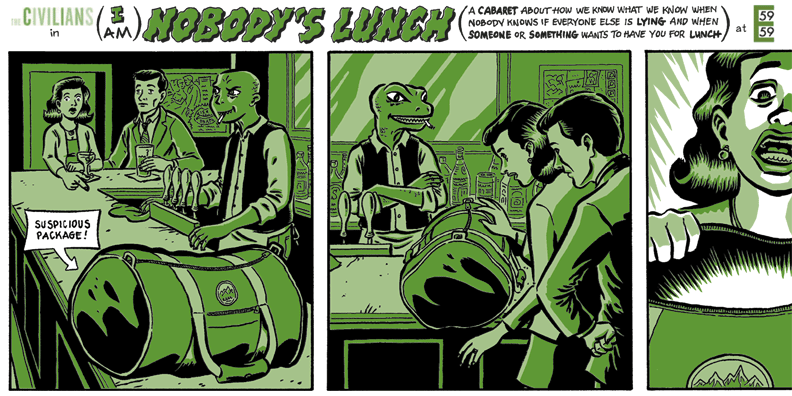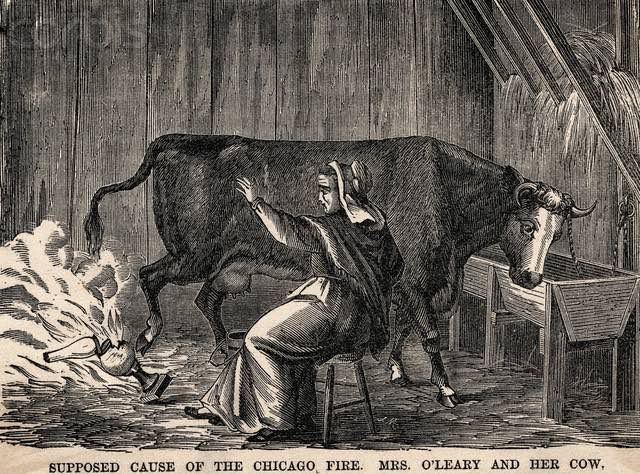
As Dana H. receives applause from critics in full, Steve Cosson reflected on how vividly he remembers interviewing Dana, a memory replayed verbatim as recordings of those interviews fill the Lyceum Theatre and Dana’s voice is channeled in a brilliant performance by Deirdre O’Connell. The resulting blend is astonishing. “I think the act of Dana speaking this story builds a kind of bridge between the time and space of the trauma,” Cosson said, “and this time, this room, whether that’s the room where she spoke to me one-on-one, or the larger room of the theater.”
Alongside hundreds of others and fellow members of The Civilians, I took my seat last Thursday and watched as the lights dimmed; Deirdre O’Connell sat down in a blue armchair facing us in the diorama-like set of a dated Florida motel room. O’Connell faced the audience as the vessel through which Dana shares her story and, like Cosson, we listened as witnesses to her story as the staging evoked the traditional orientation of an interview. Once seated, O’Connell inserted her earbuds and signaled her readiness to the technician hovering nearby. And the show began. We never heard Deirdre O’Connell speak. Instead, we heard Dana Higginbotham, mother of the show’s acclaimed playwright Lucas Hnath, along with occasional questions from Steve Cosson, as she told us her story of five months in the captivity of a white supremacist who brutally abused her in 1997. And we listened.
In 2015, Cosson initially approached Hnath about commissioning a work from him for The Civilians and Hnath shared a brief outline of his mother’s story. “I knew immediately that it was a project that he should undertake and that I would support with great enthusiasm,” Cosson shared. “The project began with my interviewing Dana for multiple sessions. The Goodman Theatre had come on board as a co-commissioner which helped us to bring Dana to New York for the interviews. Lucas’s play The Christians was in production at the time, so Dana and I sat on the stage of that set for the sessions.” Over two days, and six hours each day, Dana shared her story with Cosson. From Cosson’s sessions with Dana, Hnath used the audio and the transcriptions to draft a script which was later developed alongside the lip-syncing process in a series of workshops with director Les Waters. Hnath had shared little outside of a basic outline with Cosson prior to keep Cosson’s perspective fresh, a choice highlighted by Jesse Green in his review for The New York Times as taking “no shortcuts that might introduce doubt.”
“I typically don’t prepare questions for the interviews I do for theater, Cosson explained. “I find that I listen better if I just go in with the intention to be as present as possible, and then I let all my questions be responsive to what the person says. This was very much the case with Dana. It was really a matter of letting it all unfold. I would ask questions to draw out more detail or to get clarity on sequence, and, on very rare occasions, I would encourage her to talk more about some difficult aspect of the story, but she didn’t need much coaxing. I think she was eager and ready to tell this story, and I think once she felt that I was with her and listening in the right way, she was pretty much in the driver’s seat.” In performance, the audience steps into the role of witness for this harrowing story with an awareness that the audio has been condensed, a simple tone marking the edit points.
Rising to the exacting challenge that was presented to her, O’Connell’s technical brilliance quickly soothes any concerns that she will fall out-of-sync with the recording and pulls the audience into Dana’s story. As Adam Feldman comments for Time Out, O’Connell’s work is a “performance of virtuoso naturalism, radiant with inner life; the technique is so perfect that it disappears.” Subsequently, Feldman notes, the juxtaposition gives the play its reality while creating an “eerie sense of dissociation from its own experience.” Looking directly out at the audience for most of the play’s 75 minutes, O’Connell gives body to every laugh and sigh, every halted word, every smack of a hand and rustle of a paper. O’Connell’s lip-syncing in Cosson’s view is “so effective” because “it activates a triangulation between the real (the audio), the performance (the actor) and the observer who synthesizes the two into a kind of hyper-reality. In a sense, our engagement in putting these elements together creates a truth that is constructed of what we’re seeing and what we’re hearing, but is somehow more than both.”
The effect of actually hearing Dana’s voice has been at the heart of many critics’ praise. As Charles Isherwood writes in his review for Broadway News, Dana’s story “is so disturbing and almost gothic in its horror that it would practically beggar belief if presented in a traditional theatrical format.” He credits hearing “all the usual pauses, unfinished sentences and fragments that pepper actual conversation, as opposed to often-sculpted stage dialogue” with the play’s success at convincingly telling a real account. The nightmare that is Dana’s story unfolds almost entirely through the recording. The only break from O’Connell’s performance is after the detailed account of a particularly brutal and sickening assault. Following this moment in Dana’s story, we watch as a maid comes to clean the motel room, interview clips of Dana speaking layer over each other with increasing discordance, the lighting changing with gaining speed until the chaotic visual and sonic pressure induces a feeling of panic and claustrophobia. The combined effect conjures the relentless and oppressive experiences that she lived through day after day for months in dozens of motels across the American South. As this happens, the audience follows the maid through her routine, including her nonchalant reaction to the bed’s blood-soaked sheets.
As Ran Xia reviews for Did They Like It?, “[t]he moment rattled me, the inaction of a motel housekeeper, a woman of little consequence perhaps, who was also fearful of the world she’s adjacent to, and with fear came apathy, and with apathy came denial.” I had been similarly rattled and called in my head for the maid to notice, to care, to help, a desire that turned into resignation and some despair as she continued her work without a misstep. The power of this single moment is attributed by Green in his review to Les Waters’ direction. “One thing you get, or rather don’t, is the violent imagery that in a literal representation can short circuit other values. Higginbotham’s tale is so brutal that, were it visualized, you would spend the entire play worrying about her survival…Instead, the director Les Waters, in his nerves-of-steel staging, offers just one spot of blood to stand for the rest.” In Deadline, Greg Evans chillingly summarizes that as to whether the maid noticed the blood, “[t]he terror comes in realizing that it makes no difference either way.”
Alongside the range of emotions that the show evokes in its audience are the questions for Dana that arise as the audience occupies a place similar to Cosson’s. The audience enters with a general idea of the show’s story and sits across from O’Connell much like how Cosson sat across from Dana. Some question Dana’s reliability. Feldman handles the question with some neutrality. He writes that Dana’s account “may be distorted by trauma and time. There are things she can’t explain about what happened to her, and at times you wonder what she is leaving out or, perhaps, what Hnath has chosen not to include; wrestling with your response to Dana as a narrator is part of what makes the play so resonant.” In her review for Vulture, Helen Shaw shares her own thought process while watching. “It’s awful, but my mind occasionally fled Dana’s testimony, trying to find a way to discredit her. Why, I’d think, did she ever go back home whenever she momentarily eluded Jim? What about this detail? Or that timeline?” The questions transform as Dana’s story progresses for Shaw. She considers the effects of memory and PTSD, but then looks at the motel room set and thinks of all the hotel rooms in her own memories that blend together. “The past smears; that’s what it does. Dana H. is about people refusing to believe or see a woman, yet it also demonstrates—in real time—our own eagerness to do the same thing.” Frank Rizzo addresses the point while reviewing for Variety with the opinion that Dana H. “…is not a docudrama with everything neatly laid out and analyzed; it’s a memory play that wants its audience to step outside the narration and go beyond the voice as to see the larger story.”
“There’s a section of the interview and the play where she speaks about the gulf she feels between herself and others as someone’s who’s experienced and witnessed a reality outside of ‘normal’ society,” Cosson pointed out. Dana’s decision to speak may be what allows her to bridge those two worlds for herself. “From my perspective, one of the most important aspects of Dana’s story is the act of her telling it.”
Extended Play is a project of The Civilians. To learn more about The Civilians and to access exclusive discounts to shows, visit us and join our email list at TheCivilians.org.
Author
-

Leah Putnam (she/her) is a dramaturg from outside of Philadelphia, Pennsylvania. Prior to joining The Civilians, she worked as a dramaturg for Live Arts in Charlottesville, Virginia and has worked on developing new work with writers including LET GO OF ME by Kelley Van Dilla. She is particularly passionate about immersive theater and also has a background in costumes. Leah completed her MA in English at UVA and her BA in English at NYU.










